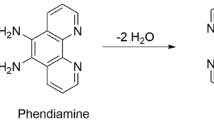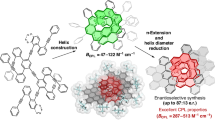Abstract
Light emission from organic light-emitting diodes that make use of fluorescent materials have an internal quantum efficiency that is typically limited to no more than 25% due to the creation of non-radiative triplet excited states. Here, we report the use of electron-donating and electron-accepting molecules that allow a very high reverse intersystem crossing of 86.5% between non-radiative triplet and radiative singlet excited states and thus a means of achieving enhanced electroluminescence. Organic light-emitting diodes made using m-MTDATA as the donor material and 3TPYMB as the acceptor material demonstrate that external quantum efficiencies as high as 5.4% can be achieved, and we believe that the approach will offer even higher values in the future as a result of careful material selection.
This is a preview of subscription content, access via your institution
Access options
Subscribe to this journal
Receive 12 print issues and online access
$209.00 per year
only $17.42 per issue
Buy this article
- Purchase on Springer Link
- Instant access to full article PDF
Prices may be subject to local taxes which are calculated during checkout






Similar content being viewed by others
References
Mitschke, U. & Bäuerle, P. The electroluminescence of organic materials. J. Mater. Chem. 10, 1471–1507 (2000).
Baldo, M. A. et al. Highly efficient phosphorescent emission from organic electroluminescent devices. Nature 395, 151–154 (1998).
Lamansky, S. et al. Highly phosphorescent bis-cyclometalated iridium complexes: synthesis, photophysical characterization, and use in organic light emitting diodes. J. Am. Chem. Soc. 123, 4304–4312 (2001).
Tsutsui, T. & Saito, S. Organic Multilayer-Dye Electroluminescent Diodes—Is There Any Difference with Polymer LED? (Kluwer Academic, 1993).
Rothberg, L. J. & Lovinger, A. J. Status of and prospects for organic electroluminescence. J. Mater. Res. 11, 3174–3187 (1996).
Adachi, C., Baldo, M. A., Thompson, M. E. & Forrest, S. R. Nearly 100% internal phosphorescence efficiency in an organic light emitting device. J. Appl. Phys. 90, 5048–5051 (2001).
Deaton, J. C. et al. E-type delayed fluorescence of a phosphine-supported Cu2(μ-NAr2)2 diamond core: harvesting singlet and triplet exactions in OLEDs. J. Am. Chem. Soc. 132, 9499–9508 (2010).
Bolton, O., Kangwon, L., Kim, H.-J., Lin, K. Y. & Kim, J. Activating efficient phosphorescence from purely organic materials by crystal design. Nature Chem. 3, 205–210 (2011).
Kondakov, D. Y., Pawlik, T. D., Hatwar, T. K. & Spindler, J. P. Triplet annihilation exceeding spin statistical limit in highly efficient fluorescent organic light-emitting diodes. J. Appl. Phys. 106, 124510 (2009).
Endo, A. et al. Thermally activated delayed fluorescence from Sn4+–porphyrin complexes and their application to organic light-emitting diodes—a novel mechanism for electroluminescence. Adv. Mater. 21, 4802–4806 (2009).
Endo, A. et al. Efficient up-conversion of triplet excitons into a singlet state and its application for organic light emitting diodes. Appl. Phys. Lett. 98, 083302 (2011).
Morteani, A. C. et al. Barrier-free electron–hole capture in polymer blend heterojunction light-emitting diodes. Adv. Mater. 15, 1708–1712 (2003).
Osaheni, J. A. & Jenekhe, S. A. Efficient blue luminescence of a conjugated polymer exciplex. Macromolecules 27, 739–742 (1994).
Berggren, M. et al. White light from an electroluminescent diode made from poly[3(4-octylphenyl)-2,2′-bithiophene] and an oxadiazole derivative. J. Appl. Phys. 76, 7530–7534 (1994).
Tamoto, N., Adachi, C. & Nagai, K. Electroluminescence of 1,3,4-oxadiazole and triphenylamine-containing molecules as an emitter in organic multilayer light emitting diodes. Chem. Mater. 9, 1077–1085 (1997).
Gebler, D. D. et al. Exciplex emission in bilayer polymer light-emitting devices. Appl. Phys. Lett. 70, 1644–1646 (1997).
Wang, J.-F. et al. Exciplex electroluminescence from organic bilayer devices composed of triphenyldiamine and quinoxaline derivatives. Adv. Mater. 10, 230–233 (1998).
Itano, K., Ogawa, H. & Shirota, Y. Exciplex formation at the organic solid-state interface: yellow emission in organic light-emitting diodes using green-fluorescent tris(8-quinolinolato)aluminum and hole-transporting molecular materials with low ionization potentials. Appl. Phys. Lett. 72, 636–638 (1998).
Chao, C.-L. & Chen S.-A. White light emission from exciplex in a bilayer device with two blue light-emitting polymers. Appl. Phys. Lett. 73, 426–428 (1998).
Noda, T., Ogawa, H. & Shirota, Y. A blue-emitting organic electroluminescent device using a novel emitting amorphous molecular material, 5,5′-bis(dimesitylboryl)-2,2′-bithiophene. Adv. Mater. 11, 283–285 (1999).
Cocchi, M. et al. Efficient exciplex emitting organic electroluminescent devices. Appl. Phys. Lett. 80, 2401–2403 (2002).
Palilis, L. C., Mäkinen, A. J., Uchida, M. & Kafafi, Z. H. Highly efficient molecular organic light-emitting diodes based on exciplex emission. Appl. Phys. Lett. 82, 2209–2211 (2003).
Matsumoto, N., Nishiyama, M. & Adachi, C. Exciplex formations between tris(8-hydoxyquinolate)aluminum and hole transport materials and their photoluminescence and electroluminescence characteristics. J. Phys. Chem. C 112, 7735–7741 (2008).
Iwata, S., Tanaka, J. & Nagakura, S. Phosphorescence of the charge-transfer triplet states of some molecular complexes. J. Chem. Phys. 47, 2203–2209 (1967).
Gordon, M. & Ware, W. R. The Exciplex (Academic Press, 1975).
Luňák, S., Nepraš, M., Hrdina, R., Kurfürst, A. & Kuthan, J. Photophysics of PBD derivatives. II. The character of the lowest excited triplet state of 2-(biphenyl-4′-yl)-5-phenyl-1,3,4-oxadiazole. Chem. Phys. 170, 77–88 (1993).
Madigan, C. F. & Bulović, V. Solid state salvation in amorphous organic thin films. Phys. Rev. Lett. 91, 247403 (2003).
Wolf, M. W., Legg, K. D., Brown, R. E., Singer, L. A. & Parks, J. H. Photophysical studies on the benzophenones. Prompt and delayed fluorescences and self-quenching. J. Am. Chem. Soc. 97, 4490–4497 (1975).
Fang, T.-S., Brown, R. E., Kwan, C. L. & Parks, J. H. Photophysical studies on benzil. Time resolution of the prompt and delayed emissions and a photokinetic study indicating deactivation of the triplet by reversible exciplex formation. J. Phys. Chem. 82, 2489–2496 (1978).
Levy, D. & Avnir, D. Room temperature phosphorescence and delayed fluorescence of organic molecules trapped in silica sol-gel glasses. J. Photochem. Photobiol. A 57, 41–63 (1991).
Smith, L. H., Wasey, J. A. E. & Barnes, W. L. Light outcoupling efficiency of top-emitting organic light-emitting diodes. Appl. Phys. Lett. 84, 2986–2988 (2004).
Granlund, T., Pettersson, L. A. A., Anderson, M. R. & Inganäs, O. Interference phenomenon determines the color in an organic light emitting diode. J. Appl. Phys. 81, 8097–8103 (1997).
Kalinowski, J. et al. Impact of high electric fields on the charge recombination process in organic light-emitting diodes. J. Phys. D 33, 2379–2387 (2000).
Giro, G., Cocchi, M., Kalinowski, J., Di Marco, P. & Fattori, V. Multicomponent emission from organic light emitting diodes based on polymer dispersion of an aromatic diamine and an oxadiazole derivative. Chem. Phys. Lett. 318, 127–141 (2000).
Gould, I. R., Young, R. H., Mueller, L. J., Albrecht, A. C. & Farid, S. Electronic structures of exciplexes and excited charge-transfer complexes. J. Am. Chem. Soc. 116, 8188–8199 (1994).
Huang, Y.-S. et al. Electronic structures of interfacial states formed at polymeric semiconductor heterojunctions. Nature Mater. 7, 483–489 (2008).
Acknowledgements
The authors thank K. Tokumaru for fruitful discussions. This work was supported in part by the Funding Program for World-Leading Innovative R&D on Science and Technology (FIRST) and the Konica Minolta Science and Technology Foundation. The authors thank the Global Centers of Excellence (COE) programme ‘Science for Future Molecular Systems’ of the Ministry of Education, Culture, Sports, Science and Technology of Japan (MEXT).
Author information
Authors and Affiliations
Contributions
K.G. and K.Y. designed the experiments, carried out the measurements of the photoluminescence and electroluminescence characteristics and discussed the experimental data with C.A. K.S. provided experimental support and suggestions. K.G. and C.A. wrote the manuscript.
Corresponding author
Ethics declarations
Competing interests
The authors declare no competing financial interests.
Supplementary information
Supplementary information
Supplementary information (PDF 867 kb)
Rights and permissions
About this article
Cite this article
Goushi, K., Yoshida, K., Sato, K. et al. Organic light-emitting diodes employing efficient reverse intersystem crossing for triplet-to-singlet state conversion. Nature Photon 6, 253–258 (2012). https://doi.org/10.1038/nphoton.2012.31
Received:
Accepted:
Published:
Issue Date:
DOI: https://doi.org/10.1038/nphoton.2012.31
This article is cited by
-
A general supramolecular strategy for fabricating full-color-tunable thermally activated delayed fluorescence materials
Nature Communications (2024)
-
Entropy-driven charge-transfer complexation yields thermally activated delayed fluorescence and highly efficient OLEDs
Nature Chemistry (2024)
-
Exciplex-forming cohost systems with 2,7-dicyanofluorene acceptors for high efficiency red and deep-red OLEDs
Scientific Reports (2024)
-
Fluorene-based conjugates with geminal donor-acceptor: synthesis, photophysical properties and theoretical studies
Journal of Chemical Sciences (2024)
-
Tuning the Electronic and Optical Properties of Phenoxaborin Based Thermally Activated Delayed Fluorescent Materials: A DFT Study
Journal of Fluorescence (2024)



